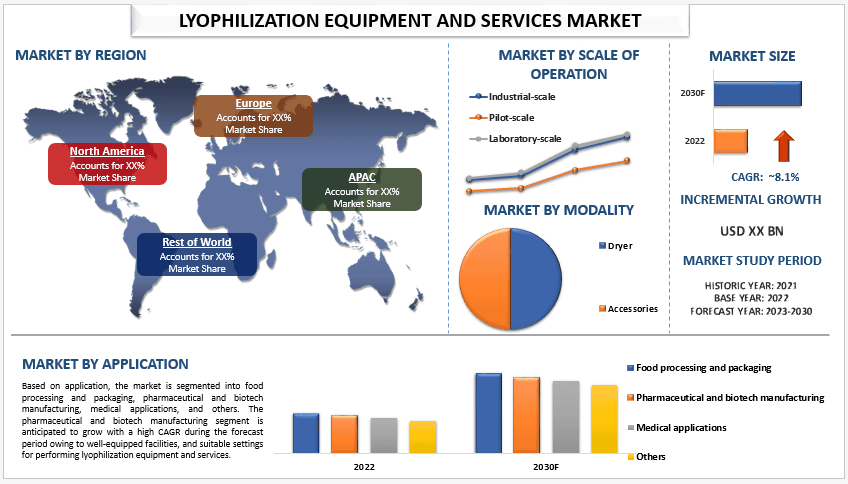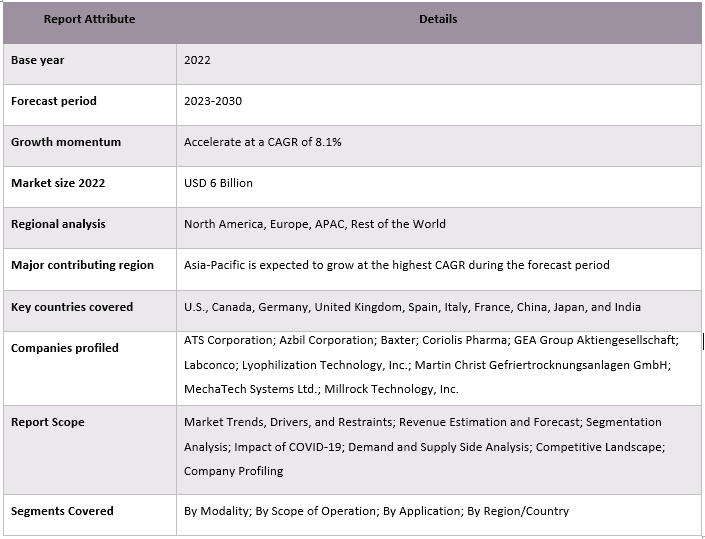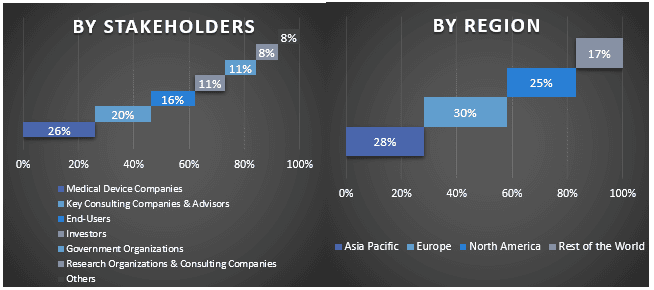- Home
- About Us
- Industry
- Services
- Reading
- Contact Us
Lyophilization Equipment and Services Market: Current Analysis and Forecast (2023-2030)
Emphasis on Modality (Dryer and Accessories); Scale of Operation (Industrial- scale, Pilot-scale, and Laboratory-scale); Application (Food Processing and Packaging, Pharmaceutical and Biotech Manufacturing, Medical Applications, and Others); Region/Country

The Lyophilization Equipment and Services Market was valued at USD 6 billion in 2022, growing at a CAGR of 8.1% during the forecast period from 2023 – 2030. Owing to the surge in usage of packaged food, rising strategic collaborations by pharmaceutical giants, improved quality of treatment procedures, and technological developments in the pharmaceutical sector. For instance, in September 2021, Spain-based DARA Pharma Group and U.S.-based MOTUS signed a technology transfer agreement to manufacture loading systems for freeze dryers. Multiple factors have led to a surge in the market including the rising research & development activities throughout the world. Also, numerous pharmaceutical companies are developing strategic alliances and competing to develop efficient lyophilization devices, which is also boosting the market growth. For instance, in February 2022, U.S.-based AMGEN announced its collaboration with Plexium Inc. where the two companies will research and develop new protein therapeutics agents for the treatment of cancer along with other serious diseases.
Some of the major players operating in the market include ATS Corporation; Azbil Corporation; Baxter; Coriolis Pharma; GEA Group Aktiengesellschaft; Labconco; Lyophilization Technology, Inc.; Martin Christ Gefriertrocknungsanlagen GmbH; MechaTech Systems Ltd.; Millrock Technology, Inc. Several M&As along with partnerships have been undertaken by these players to facilitate customers with hi-tech and innovative products/technologies.
Insights Presented in the Report
“Amongst modality, the dryer segment to grow with high CAGR during the forecast period”
Based on the modality, the market is bifurcated into dryers and accessories. The dryer segment is expected to grow with a high CAGR during the forecast period owing to a surge in the utilization of lyophilization equipment dryers in food processing and packaging companies as well as pharmaceutical and biotech companies. The dryer includes tray-style freeze dryers, manifold freeze dryers, and rotary freeze dryers. The recent trends of increased research & development activities and a surge in drug development in pharmaceutical industries are propelling this segment. For instance, in November 2021, Barcelona-based Telstar, a machinery industry, launched the Usifroid global service platform for retrofitting & maintenance of freeze-dryers, to optimize and extend the life cycle of freeze-drying equipment. Thus, above mentioned factors are driving the segment growth during the forthcoming period.
“Amongst scope of operation, the industrial- scale held the dominant share of the market in 2022”
By scope of operation, the market is segmented into industrial-scale, pilot-scale, and laboratory-scale. The industrial-scale segment held the dominant share of the market in 2022 attributed to the rising prevalence of aseptic food packaging and the rising demand and manufacturing of protein-based drugs. Multiple pharmaceutical companies and food companies are draining their funds and efforts to bring a potent solution to meet market demands. For instance, the Pharmaceutical Journal reported lyophilization as one of the most employed processes in pharmaceutical industries for manufacturing pharmaceutical products that have a thermo-sensitive and unstable form of the aqueous medium. The European Federation of Pharmaceutical Industries and Associations (EFPIA) also estimated that the investment in research and development by pharmaceutical companies has been increasing in recent times with 4.6% growth from the year 2020 to 2021, which is expected to be followed in the forthcoming years.
“Amongst application, the pharmaceutical and biotech manufacturing segment to grow with high CAGR during the forecast period”
Based on application, the market is segmented into food processing and packaging, pharmaceutical and biotech manufacturing, medical applications, and others. The pharmaceutical and biotech manufacturing segment is anticipated to grow with a high CAGR during the forecast period owing to well-equipped facilities, and suitable settings for performing lyophilization equipment and services. An increasing number of pharmaceutical sales, including lyophilized drugs are boosting the growth of this segment in the market. For instance, in February 2022, U.S-based Lyophilization Technology Inc. launched its new innovative lyophilization processing products in dual-chamber syringes and cartridges. The equipment provides a wide variety of product processing ranging from biologics such as a vaccine, and proteins to small molecules. Thus, amongst applications, the pharmaceutical and biotech manufacturing segment is expected to grow with a high CAGR during the forecast period.
“North America held a significant share of the market in the year 2022”
For a better understanding of the market adoption of the lyophilization equipment and services industry, the market is analyzed based on its worldwide presence in countries such as North America (U.S., Canada, Rest of North America), Europe (Germany, U.K., France, Spain, Italy, Rest of Europe), Asia-Pacific (China, Japan, India, Rest of Asia-Pacific), Rest of World. North America held a significant share of the market in 2022. Several factors such as increasing healthcare expenditure, the surge in the prevalence of packaged food and nutraceuticals, and the presence of most key players and their associated surge in the lyophilization equipment and services are driving the regional market. Moreover, the new product developments, along with approvals and launches, helped the market to grow over the study period. For instance, according to the European Federation of Pharmaceutical Industries and Associations data for the pharmaceutical industry for 2022, North America held 49.1% of world pharmaceutical sales in 2021, compared with 23.4% in the European region. Therefore, North America held a significant share of the market in the year 2022.
Q1: What is the current market size and growth potential of the lyophilization equipment and services market?
Ans: The lyophilization equipment and services market was valued at USD 6 Billion in 2022 and is expected to grow a CAGR of 8.1% during the forecast period (2023-2030).
Q2: What are the driving factors for the growth of the lyophilization equipment and services market?
Increasing healthcare expenditure, the surge in the prevalence of packaged food and nutraceuticals, and the presence of most key players and their associated surge in the lyophilization equipment and services are the driving factors for the growth of lyophilization equipment and services.
Q3: Which segment has the largest share of the lyophilization equipment and services market by modality?
Ans: The accessories segment has the largest share of the lyophilization equipment and services market by modality.
Q4: What are the emerging technologies and trends in the lyophilization equipment and services market?
Ans: Growing demand for personalized medicines and a shift towards contract lyophilization services are emerging trends in the lyophilization equipment and services market.
Q5: Which region will dominate the lyophilization equipment and services market?
Ans: North America is expected to dominate the market during the forecast period.
Q6: Who are the key players operating in the lyophilization equipment and services market?
Ans: ATS Corporation; Azbil Corporation; Baxter; Coriolis Pharma; GEA Group Aktiengesellschaft; Labconco; Lyophilization Technology, Inc.; Martin Christ Gefriertrocknungsanlagen GmbH; MechaTech Systems Ltd.; Millrock Technology, Inc. are the key players operating in the lyophilization equipment and services market.
Lyophilization Equipment and Services Market Report Coverage

Reasons to buy this report:
- The study includes market sizing and forecasting analysis validated by authenticated key industry experts.
- The report presents a quick review of overall industry performance at one glance.
- The report covers an in-depth analysis of prominent industry peers with a primary focus on key business financials, product portfolios, expansion strategies, and recent developments.
- Detailed examination of drivers, restraints, key trends, and opportunities prevailing in the industry.
- The study comprehensively covers the market across different segments.
- Deep dive regional level analysis of the industry.
Customization Options:
The global lyophilization equipment and services market can further be customized as per the requirement or any other market segment. Besides this, UMI understands that you may have your own business needs, hence feel free to connect with us to get a report that completely suits your requirements.
Table of Content
Research Methodology for the Lyophilization Equipment and Services
Market Analysis (2023-2030)
Analyzing the historical market, estimating the current market, and forecasting the future market of the global lyophilization equipment and services market were the three major steps undertaken to create and analyze the adoption of lyophilization equipment and services in major regions globally. Exhaustive secondary research was conducted to collect the historical market numbers and estimate the current market size. Secondly, to validate these insights, numerous findings and assumptions were taken into consideration. Moreover, exhaustive primary interviews were also conducted, with industry experts across the value chain of the global lyophilization equipment and services market. Post assumption and validation of market numbers through primary interviews, we employed a top-down/bottom-up approach to forecasting the complete market size. Thereafter, market breakdown and data triangulation methods were adopted to estimate and analyze the market size of segments and sub-segments of the industry pertains to. Detailed methodology is explained below:
Analysis of Historical Market Size
Step 1: In-Depth Study of Secondary Sources:
Detail secondary study was conducted to obtain the historical market size of the lyophilization equipment and services market through company internal sources such as annual reports & financial statements, performance presentations, press releases, etc., and external sources including journals, news & articles, government publications, competitor publications, sector reports, third-party database, and other credible publications.
Step 2: Market Segmentation:
After obtaining the historical market size of the lyophilization equipment and services market, we conducted a detailed secondary analysis to gather historical market insights and share for different segments & sub-segments for major regions. Major segments are included in the report as modality, scope of operation, application, and region. Further country-level analyses were conducted to evaluate the overall adoption of testing models in that region.
Step 3: Factor Analysis:
After acquiring the historical market size of different segments and sub-segments, we conducted a detailed factor analysis to estimate the current market size of the lyophilization equipment and services market. Further, we conducted factor analysis using dependent and independent variables such as modality, scope of operation, application, and region of the lyophilization equipment and services market. A thorough analysis was conducted for demand and supply-side scenarios considering top partnerships, mergers and acquisitions, business expansion, and product launches in the lyophilization equipment and services market sector across the globe.
Current Market Size Estimate & Forecast
Current Market Sizing: Based on actionable insights from the above 3 steps, we arrived at the current market size, key players in the global lyophilization equipment and services market, and market shares of the segments. All the required percentage shares split, and market breakdowns were determined using the above-mentioned secondary approach and were verified through primary interviews.
Estimation & Forecasting: For market estimation and forecast, weights were assigned to different factors including drivers & trends, restraints, and opportunities available for the stakeholders. After analyzing these factors, relevant forecasting techniques i.e., the top-down/bottom-up approach were applied to arrive at the market forecast for 2030 for different segments and sub-segments across the major markets globally. The research methodology adopted to estimate the market size encompasses:
- The industry’s market size, in terms of revenue (USD) and the adoption rate of the lyophilization equipment and services market across the major markets domestically
- All percentage shares, splits, and breakdowns of market segments and sub-segments
- Key players in the global lyophilization equipment and services market in terms of products offered. Also, the growth strategies adopted by these players to compete in the fast-growing market
Market Size and Share Validation
Primary Research: In-depth interviews were conducted with the Key Opinion Leaders (KOLs) including Top Level Executives (CXO/VPs, Sales Head, Marketing Head, Operational Head, Regional Head, Country Head, etc.) across major regions. Primary research findings were then summarized, and statistical analysis was performed to prove the stated hypothesis. Inputs from primary research were consolidated with secondary findings, hence turning information into actionable insights.
Split of Primary Participants in Different Regions

Market Engineering
The data triangulation technique was employed to complete the overall market estimation and to arrive at precise statistical numbers for each segment and sub-segment of the global lyophilization equipment and services market. data was split into several segments & sub-segments post studying various parameters and trends in the areas of the modality, scope of operation, application, and region in the global lyophilization equipment and services market.
The main objective of the Global Lyophilization Equipment and Services Market Study
The current & future market trends of the global lyophilization equipment and services market were pinpointed in the study. Investors can gain strategic insights to base their discretion for investments on the qualitative and quantitative analysis performed in the study. Current and future market trends determined the overall attractiveness of the market at a regional level, providing a platform for the industrial participant to exploit the untapped market to benefit from a first-mover advantage. Other quantitative goals of the studies include:
- Analyze the current and forecast market size of the lyophilization equipment and services market in terms of value (USD). Also, analyze the current and forecast market size of different segments and sub-segments
- Segments in the study include areas of the modality, scope of operation, application, and region.
- Define and analysis of the regulatory framework for the lyophilization equipment and services industry
- Analyze the value chain involved with the presence of various intermediaries, along with analyzing customer and competitor behaviors of the industry
- Analyze the current and forecast market size of the lyophilization equipment and services market for the major region
- Major countries of regions studied in the report include Asia Pacific, Europe, North America, and the Rest of the World
- Company profiles of the lyophilization equipment and services market and the growth strategies adopted by the market players to sustain in the fast-growing market
- Deep dive regional level analysis of the industry
Related Reports
Customers who bought this item also bought










